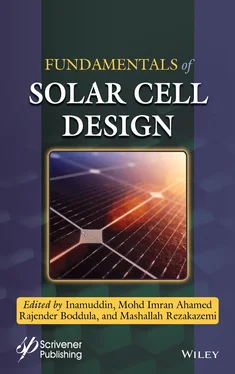This book provides a comprehensive overview on solar cells and explores the history to evolution and present scenarios of solar cell design, classification, properties, various semiconductor materials, thin films, wafer-scale, transparent solar cells, and so on. It also includes solar cells’ characterization analytical tools, theoretical modeling, practices to enhance conversion efficiencies, applications, and patents. This book is a unique reference guide that can be used by faculty, students, researchers, engineers, device designers, and industrialists who are working and learning in the fields of semiconductors, chemistry, physics, electronics, light science, material science, flexible energy conversion, industrial, and renewable energy sectors. This book includes the 16 chapters and the summaries are given below.
Chapter 1highlights a variety of organic solar cells, documented in recent literature, developed to study solar cell efficiencies, with polymer donors and organic small molecule acceptors or as donors and acceptors.
Chapter 2discusses the plasmonic solar cells with a focus on the fundamental principle of solar cell, types and design of plasmonic metallic nanostructures and devices, novel properties of surface plasmon resonance, and energy conversion efficiency. The chapter explains about device mechanisms, solar cell design, and advancements in plasmonic solar cells to generate clean energy and solar fuels.
Chapter 3discusses the current problem of the energy crisis, depletion of conventional energy resource, and serious threat of global warming. The chapter discusses the Tandem solar cells’ developments in the last few years.
Chapter 4discusses solar cells based on three different thin films, e.g., amorphous silicon, cadmium telluride, and copper indium gallium selenide. Additionally, the structure of thin films and various coating techniques are discussed. Moreover, this chapter summarizes the modifications and performance improvement of thin-film solar cells.
Chapter 5comprises a brief discussion about the biohybrid solar cells, suitable substrate selection for fabrication, as well as the role of photosynthesis in biohybrid solar cells. The chapter discusses some biomimetic approaches borrowed from photosynthetic organisms and plants which can be implemented in biohybrid solar cells.
Chapter 6deals with various features of dye-sensitized solar cells (DSSCs). Here, the simple construction and working mechanism besides various components of DSSCs are elaborately discussed. Also, the various materials used for electrolytes and natural dyes are explained briefly along with performances of DSSCs.
Chapter 7addresses various computational methodologies from molecular mechanics to quantum mechanics for evaluation of compounds in terms of structural and electronic properties. The main objective is the assessment of photovoltaic parameters including absorption spectra, charge transfer, open-circuit voltage, peak current density, efficiency in light, and molecular descriptors toward the efficient performance of solar cells.
Chapter 8provides a solar radiation analysis of a region through the use of deterministic models following the specified climatic circumstances. The analysis includes a quantitative analysis for the selection of optimum solar system equipment.
Chapter 9describes the developments in photovoltaic materials and related devices. Brief description of solar cell generations and the factors that affect efficiency are reviewed. The prospects regarding practices to enhance the conversion efficiencies are shortly presented.
Chapter 10discusses the efficiencies and materials of conventional, modern, and emerging solar cell technologies. The use of inorganic, organic, and hybrid materials for a rational design of solar cells is discussed in detail. Additionally, the challenges faced by solar cell technologies and performance enhancement techniques are also discussed briefly.
Chapter 11highlights the latest and emerging characterization tools to study and investigate the properties and efficiency of solar cells. The emerging characterization tools discussed in this chapter are conductive atomic force microscopy, electron tomography, transient absorption spectroscopy, Kelvin probe microscopy, and surface morphology observation.
Chapter 12briefly describes the historic evolution, fundamental properties, and working principles of photovoltaic cells of various types. The discussion about the efficiency and applications of these solar cells helps the new researchers to develop new technologies and improve their work in the area of solar cell systems.
Chapter 13gives a detailed overview of the current efforts to enhance the stability of perovskite solar cell; moreover, the degradation causes and mechanisms are summarized. The strategies to improve device stability are portrayed in terms of structural effects, a photoactive layer, holeand electron-transporting layers, electrode materials, and device encapsulation.
Chapter 14presents the progress of solar cells and their latest developments. The major goal is to show how they can be utilized for photovoltaic energy generation as a renewable energy source. This will help to identify the challenges and drawing prospects for the researchers in this field to further improve and develop solar cells and their applications.
Chapter 15discusses the design, materials, and applications of semitransparent perovskite solar cells. Different device architectures and the performance evaluation parameters are discussed in detail. The materials used in the photoactive layer, charge transport layers, and transparent electrodes are also presented in addition to the major applications and future scope of semitransparent perovskite solar cells.
Chapter 16presents an overview of flexible solar cell technology. The various aspects of this technology such as material requirements, and material and cell level characterization techniques and applications are discussed in detail. The chapter is primarily focused on developing an understanding of the current status and future challenges of flexible photovoltaic technology.
Inamuddin
Mohd Imran Ahamed
Rajender Boddula
Mashallah Rezakazemi
June 2021
Yadavalli Venkata Durga Nageswar1* and Vaidya Jayathirtha Rao2
1CSIR - Indian Institute of Chemical Technology, Hyderabad, India
2Hetero Research Foundation, TSIE, Balanagar, Hyderabad, India
Abstract
Limitations faced in using fullerene as an acceptor molecule in BHJOSCs directed research toward non-fullerene–based acceptors in BHJOSCs. Polymer donor and small-molecule acceptor combination is successfully explored to develop higher performance BHJOSCs. Various novel small acceptor organic materials are synthesized and fabricated as sBHJOSCs in combination with suitable polymer donors available. Performances of organic solar cells improved to over 17%, and further, it may cross even 20%. Simultaneously, researchers explored fullerene all small molecules for BHJOSCs. All small-molecule BHJOSCs do not use polymer donor due to certain limitations. Progress achieved from these investigations is remarkable and the efficiency displayed is around 14%. Both the research lines are found to be exceptional and will provide further improvement in the solar cell efficiency. Various examples discussed in this chapter deal with the recent research results reported in the literature on both the research domains.
Keywords:UV-visible absorption, device architecture, film morphology, non-fullerene blends, all small organic molecules, optical band-gap, photovoltaic parameters, photo conversion efficiency
Читать дальше












